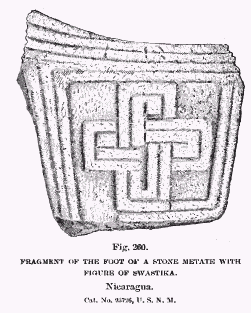

The Swastika
Dispersion of the Swastika
 Indian
who thus represents the four winds of heaven. He who made the Swastika
recognizes an occult power for good and against evil, and he thereby invokes
the power to secure prosperity. She who made the quilt pattern apparently
knew nothing of the old-time Swastika, and was not endeavoring to reproduce
it or anything like it. She only sought to make such an arrangement of
rhomboidal and triangular quilt patches as would produce a new ornamental
pattern.
Indian
who thus represents the four winds of heaven. He who made the Swastika
recognizes an occult power for good and against evil, and he thereby invokes
the power to secure prosperity. She who made the quilt pattern apparently
knew nothing of the old-time Swastika, and was not endeavoring to reproduce
it or anything like it. She only sought to make such an arrangement of
rhomboidal and triangular quilt patches as would produce a new ornamental
pattern. Nicaragua.
The specimen shown in fig. 260 (Cat. No. 23726, U. S. N. M.) is a fragment, the foot of a large stone metate from Zapatero, Granada, Nicaragua. The metate was chiseled or pecked out of the solid. A sunken panel is surrounded by moldings, in the center of which appears, from its outline, also by raised moldings, a figure, the outline of which is a Greek cross, but whose exterior is a Swastika. Its form as such is perfect, except that one bent arm is separated from its stem by a shallow groove.
"The Cross, Ancient and Modern," by W. W. Blake, shows, in its fig. 57, a Swastika pure and simple, and is cited by its author as representing a cross found by Squier in Central America. The Mexican enthusiast, Orozco y Perra, claims at first glance that it shows Buddhist origin, but I have not been able as yet to verify the quotation.
Dr. Schliemann reports, in the Ethnological Museum at Berlin, a pottery bowl from Yucatan ornamented with a Swastika, the two main arms crossing at right
 angles,
and he adds, (1) citing Le Plougeon,
"Fouilles an Yucatan," that "during the last excavations
in Yucatan this sign was found several times on ancient pottery."
angles,
and he adds, (1) citing Le Plougeon,
"Fouilles an Yucatan," that "during the last excavations
in Yucatan this sign was found several times on ancient pottery."Le Plongeon discovered a fragment of a stone slab in the ancient Maya city of Mayapan, of which he published a description in the Proceedings of the American Antiquarian Society. It contains an ogee Swastika (tetraskelion), with ends curved to the left and an inverted U with a wheel (fig. 261). Le Plongeon believed it to be an Egyptian inscription, which he translated thus: The character, inverted U, stood for Ch or K; the wheel for the sun, Aa or Ra, and the Swastika for Ch or K, making the whole to be Chach or Kak, which, he says is the word fire in the Maya language. (2)
A fragment of a metate (Cat. No. 9693, U. S. N. M.) found on Lempa River, Costa Rica, by Capt. J. M. Dow, has on its bottom a Swastika similar to that on the metate from Nicaragua. Specimen No. 59182, U. S. M. N., is a fragment of a pottery vase from Las Huacas, Costa Rica, collected by Dr. J. F. Bransford. It is natural maroon body color, decorated with black paint. A band two inches wide is around the belly of the vase divided into panels of solid black alternated with fanciful geometric figures, crosses, circles, etc. One of these panels contains a partial Swastika figure. The two main arms cross at right angles in Greek form. It is partial Swastika in that, while the two perpendicular arms bend at right angles, turning six times to the right; the two horizontal arms are solid black in color, as though the lines and spaces had run together.
Brazil.
The leaden idol (fig. 125) (Artemis Nana (3) of Chaldea, Sayce; statuettes of the Cyclades, Lenormant) found by Dr. Schliemann in the third, the burnt city of Hissarlik, Troy, was described (p. 829) with its Swastika on the triangular shield covering the pudendum, with the statement that it would be recalled in the chapter on Brazil.
The aboriginal women of Brazil wore a triangular shield or plaque over their private parts. These shields are made of terra cotta, quite thin, the edges rounded, and the whole piece rubbed smooth and polished. It is supported in place by cords around the body, which are attached by small holes in each angle of the triangle. The U. S. National Museum possesses several of these plaques from Brazil, and several were shown at the Chicago Exposition.
ENDNOTES:
1. "Troja," p. 122. [Back]
2. The presence of the Swastika is the only purpose of this citation. The correctness of the translation is not involved and is not vouched for. Back
3. Equivalent to Istar of Assyria and Babylon, Astarto of Phenicia, to the Greek Aphrodite, and the Roman Venus. Back
<< Previous Page Next Page >>
© 2004-2007 Northvegr.
Most of the material on this site is in the public domain. However, many people have worked very hard to bring these texts to you so if you do use the work, we would appreciate it if you could give credit to both the Northvegr site and to the individuals who worked to bring you these texts. A small number of texts are copyrighted and cannot be used without the author's permission. Any text that is copyrighted will have a clear notation of such on the main index page for that text. Inquiries can be sent to info@northvegr.org. Northvegr™ and the Northvegr symbol are trademarks and service marks of the Northvegr Foundation.

|